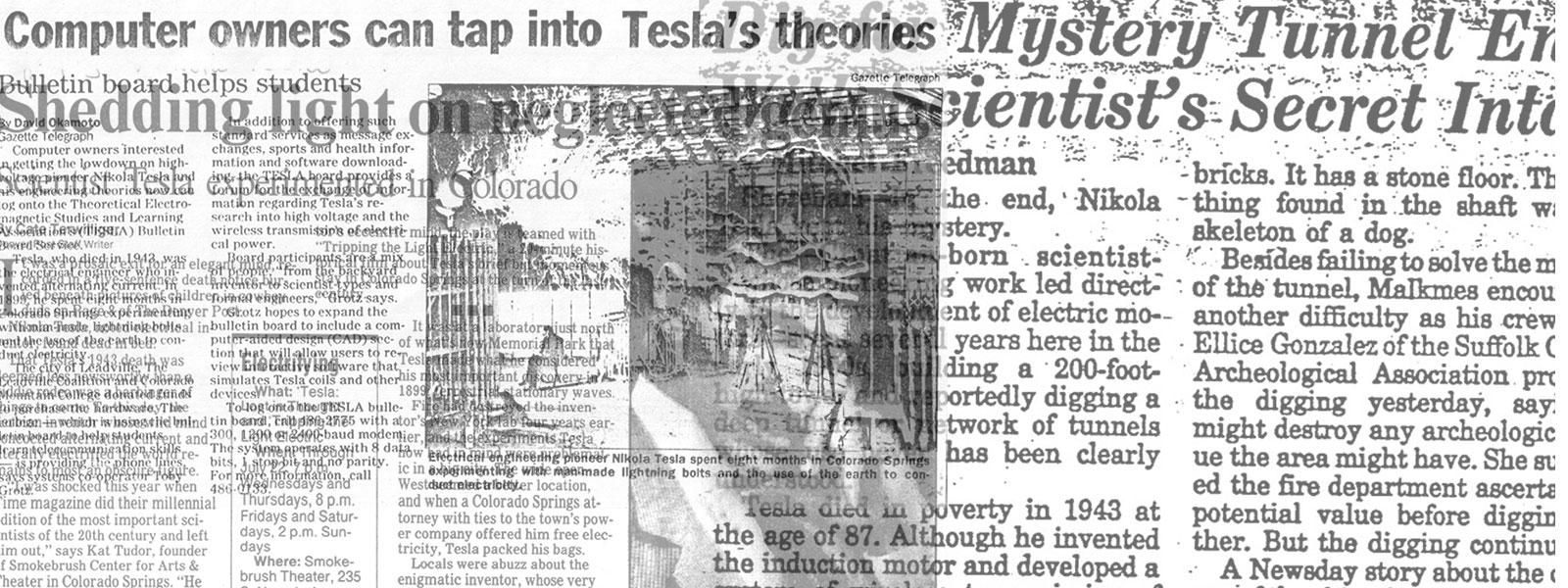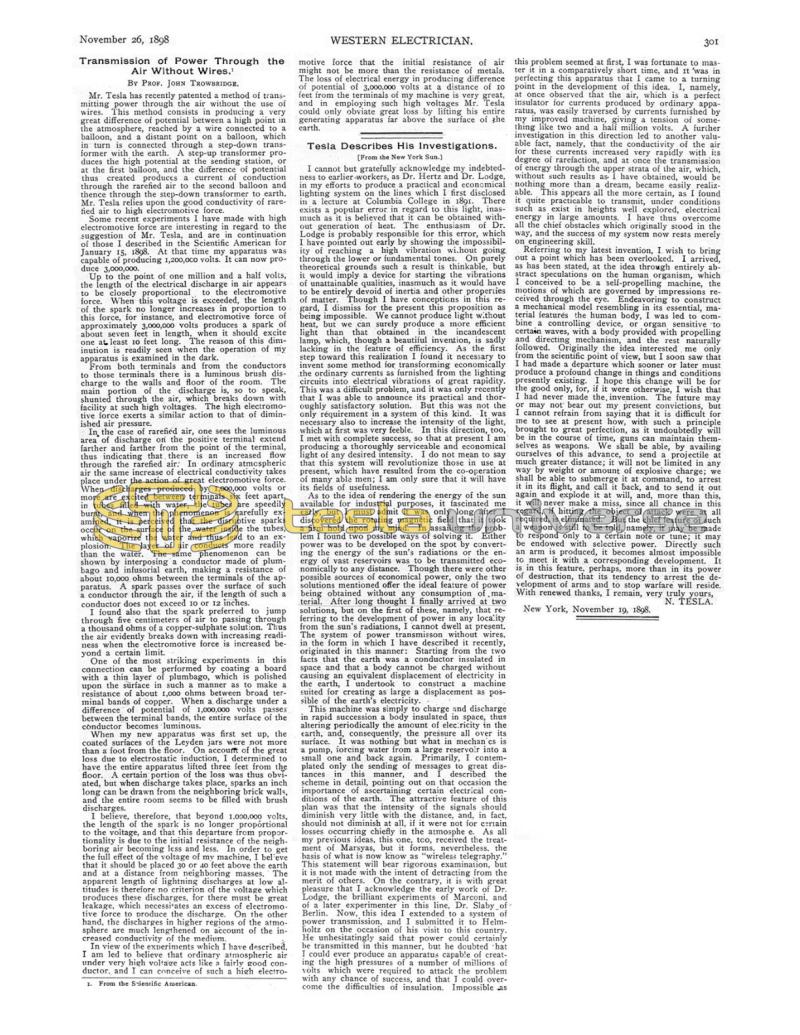
Nikola Tesla Articles
Transmission of Power Through the Air Without Wires
Mr. Tesla has recently patented a method of transmitting power through the air without the use of wires. This method consists in producing a very great difference of potential between a high point in the atmosphere, reached by a wire connected to a balloon, and a distant point on a balloon, which in turn is connected through a step-down transformer with the earth. A step-up transformer produces the high potential at the sending station, or at the first balloon, and the difference of potential thus created produces a current of conduction through the rarefied air to the second balloon and thence through the step-down transformer to earth. Mr. Tesla relies upon the good conductivity of rarefied air to high electromotive force.
Some recent experiments I have made with high electromotive force are interesting in regard to the suggestion of Mr. Tesla, and are in continuation of those I described in the Scientific American for January 15, 1898. At that time my apparatus was capable of producing 1,200,000 volts. It can now produce 3,000,000.
Up to the point of one million and a half volts, the length of the electrical discharge in air appears to be closely proportional to the electromotive force. When this voltage is exceeded, the length of the spark no longer increases in proportion to this force, for instance, and electromotive force of approximately 3,000,000 volts produces a spark of about seven feet in length, when it should excite one at least 10 feet long. The reason of this diminution is readily seen when the operation of my apparatus is examined in the dark.
From both terminals and from the conductors to those terminals there is a luminous brush discharge to the walls and floor of the room. The main portion of the discharge is, so to speak, shunted through the air, which breaks down with facility at such high voltages. The high electromotive force exerts a similar action to that of diminished air pressure.
In the case of rarefied air, one sees the luminous area of discharge on the positive terminal extend farther and farther from the point of the terminal, thus indicating that there is an increased flow through the rarefied air: In ordinary atmospheric air the same increase of electrical conductivity takes place under the action of great electromotive force. When discharges produced by 1,000,000 volts or more are excited between terminals six feet apart, in tubes filled with water, the tubes are speedily burst, and when the phenomenon is carefully examined, it is perceived that the disruptive sparks occur on the surface of the water inside the tubes, which vaporize the water and thus lead to an explosion. The layer of air conducts more readily than the water. The same phenomenon can be shown by interposing a conductor made of plumbago and infusorial earth, making a resistance of about 10,000 ohms between the terminals of the apparatus. A spark passes over the surface of such a conductor through the air, if the length of such a conductor does not exceed 10 or 12 inches.
I found also that the spark preferred to jump through five centimeters of air to passing through a thousand ohms of a copper-sulphate solution. Thus the air evidently breaks down with increasing readiness when the electromotive force is increased beyond a certain limit.
One of the most striking experiments in this connection can be performed by coating a board with a thin layer of plumbago, which is polished upon the surface in such a manner as to make a resistance of about 1,000 ohms between broad terminal bands of copper. When a discharge under a difference of potential of 1,000,000 volts passes between the terminal bands, the entire surface of the conductor becomes luminous.
When my new apparatus was first set up, the coated surfaces of the Leyden jars were not more than a foot from the floor. On account of the great loss due to electrostatic induction, I determined to have the entire apparatus lifted three feet from the floor. A certain portion of the loss was thus obviated, but when discharge takes place, sparks an inch long can be drawn from the neighboring brick walls, and the entire room seems to be filled with brush discharges.
I believe, therefore, that beyond 1,000,000 volts, the length of the spark is no longer proportional to the voltage, and that this departure from proportionality is due to the initial resistance of the neighboring air becoming less and less. In order to get the full effect of the voltage of my machine, I believe that it should be placed 30 or 40 feet above the earth and at a distance from neighboring masses. The apparent length of lightning discharges at low altitudes is therefore no criterion of the voltage which produces these discharges, for there must be great leakage, which necessitates an excess of electromotive force to produce the discharge. On the other hand, the discharges in higher regions of the atmosphere are much lengthened on account of the increased conductivity of the medium.
In view of the experiments which I have described, I am led to believe that ordinary atmospheric air under very high voltage acts like a fairly good conductor, and I can conceive of such a high electromotive force that the initial resistance of air might not be more than the resistance of metals. The loss of electrical energy in producing difference of potential of 3,000,000 volts at a distance of 10 feet from the terminals of my machine is very great, and in employing such high voltages Mr. Tesla could only obviate great loss by lifting his entire generating apparatus far above the surface of the earth.
